Facing the Unknown
History, art, loss, recovery
D. Graham Burnett
It is a basic problem. Fundamental. Pervasive. The problem at the heart of historical practice, individual identity, collective memory. Art too, perhaps. It is, in effect, the problem of death among the living: What of what has been lost can be recovered?
In the domain of metaphysics, answers range from the centripetal visions of a Final Judgment (everything, at least for a moment and/or an eternity) to the liberating enslavement of Nietzsche’s Eternal Recurrence (ditto—though not quite in the same way) across to the mothsmoke doctrine of maya (recover? what was lost? but my friend, it never was…). More pragmatic sallies at the same large problem include taxidermy, municipal archives, hard-hat archaeology, and modern historiography. Somewhere between those sweeping eschatological strategies (God, Time, the Void) and that clutch of mincing antiquarian-cum-academic tactics (lye soap, shovels, epigraphy) lie various mid-range programs for the creative constitution of nature, self, and society through acts of “recovery”: e.g., environmentalism, psychoanalysis, nationalism. Each of these makes a recuperation of the effaced into a veritable gateway to our future.
Everything seems, eventually, to go away, to be broken, damaged, forgotten; to be devoured by time. Despite our needs and desires, very little can be restored. Thus the conditions of restoration are forever vexed: Who will do it? How? To what ends? On what authority? To what effects?
• • •
So the problem is large. Interestingly, however, much of it can be made to pass through a very small space. A tiny space. A space like the narrow strip of poplar panel to the immediate right of the Madonna in Duccio di Buoninsegna’s Maestà of 1311. There, several hundred years of fluctuating temperature and humidity in the hilltop town of Siena (together with the other vicissitudes of existence—war, neglect, the equally destructive excesses of loving devotion) succeeded, by the early 1950s, in depriving the world of several square inches of paint that once represented a bit of patterned cloth folded over the throne of the Mother of Heaven.
What to do? What to do with this small hole—this lacuna, this blank, this discrete region of loss—pocking the world’s artistic patrimony? How to recover what was lost?
The easy answer would seem to be: Paint it back in. There’s plenty of contextual evidence about how that strip once looked: it’s a patterned cloth, after all. Patterns are, by definition, highly redundant. To put it in terms of information theory, they can still convey their message under very “noisy” conditions. Hence one can, without too much difficulty, reconstruct how the filigree of the cloth must have worked across the region in question. This would be an interpolation, to be sure, but one could feel relatively confident about the exercise.
And indeed, such minor restorative exercises—together with more fulsome interventions—have long been the work of that ill-defined community of practical custodians of the western artistic tradition. We call them “restorers” or “conservators” now, but for most of the history of painting in Europe they had no formal title or guild. They were artists and connoisseurs who, with varying degrees of success, took brush and palette to the work of their forebears for the purpose of touching up damaged goods. It was an empirical matter. A matter of craft. Of skill, to be sure, but also of knack. A sideline business, on the whole. Untheorized. Patrons might quibble about a tint or stroke. A sexton might complain about the cost. But this was not a formally polemical domain. Now and again, admittedly, an overzealous artist-restorer might get in trouble for carrying his gifts of pastiche all the way across to a culpable forgery, but this sort of showdown was uncommon. The navigable waters between fixing and faking were broad.
And it’s here that the absence of a theory begins to intrude, since a proper distinction between “restoring” and “forging” is, when you stop and think about it, hard to articulate clearly. Are “restorations” simply small forgeries, contextually integrated, and done without (excessively) mercenary intent and/or malice? Such a back-of-the-envelope definition, however appealing, tends to trouble any tidy sense of the difference between recovery and invention, between history and fiction, and finally, perhaps, between truth and falsehood. Putting aside the important problem of how these matters were parsed by actors and thinkers across the historical periods in question (and ideas about the “original,” the “copy,” and the “fake” certainly changed a great deal between the Renaissance and the early twentieth century), one is left with what feels like, for better or worse, a philosophical problem. Maybe several.
Which brings us back to that little lacuna in Duccio’s altarpiece, and to the philosophically inclined man who spent a good deal of time in the early 1950s looking at that hole, considering what was to be done: an Italian poet, critic, and aesthete named Cesare Brandi, who would become the most important theorist of restauro—restoration—in the twentieth century. He would become the brooding philosopher of what could be recovered.

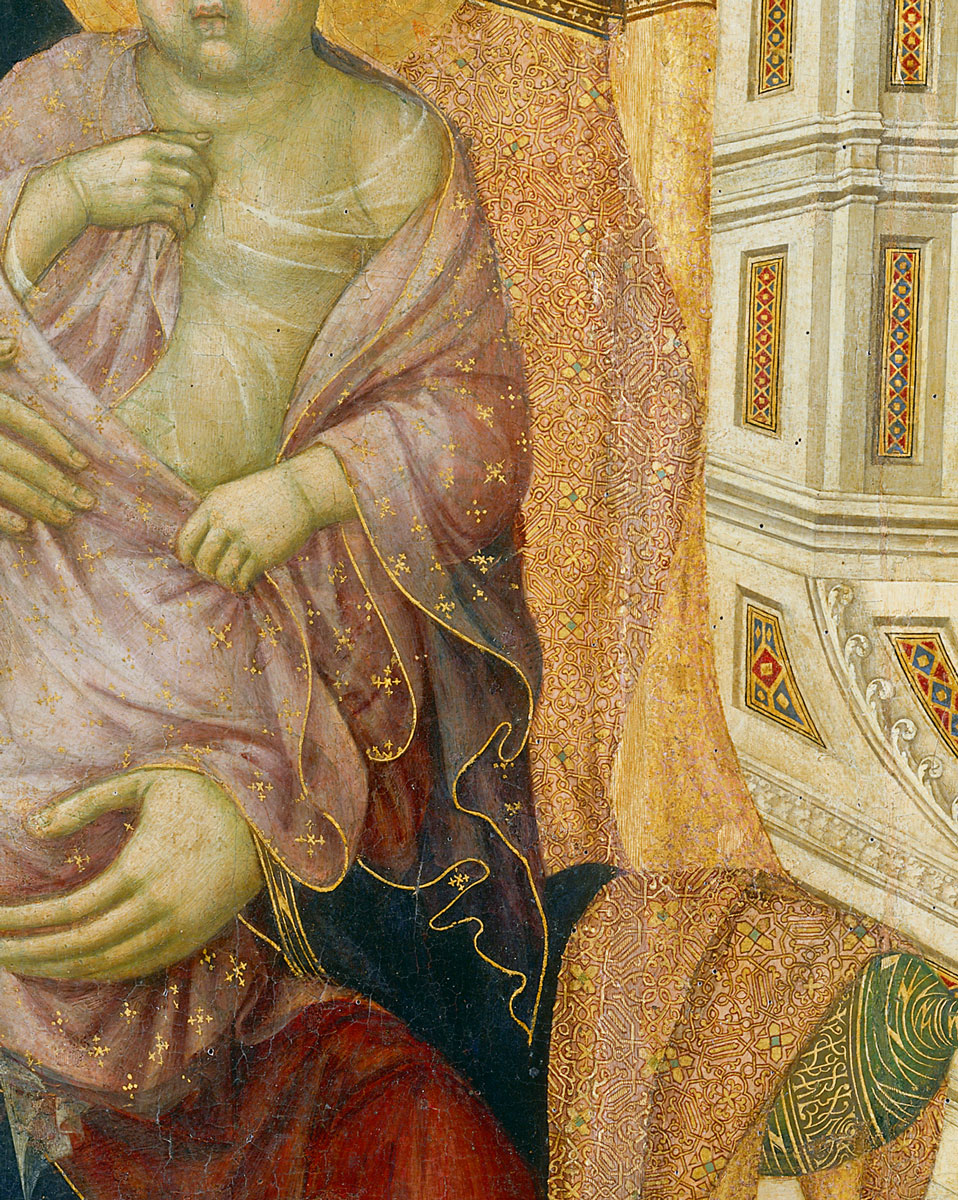
Brandi was born in Siena in 1906, and he studied law before committing himself fully to the arts. By the early 1930s, after completing a thesis at the University of Florence on Italian Mannerism, he had curated a landmark exhibition of early Renaissance religious paintings. And shortly thereafter he won a distinguished appointment in the growing (Fascist) bureaucracy dedicated to the protection and promotion of Italy’s vast heritage of classical masterworks. Like others of his generation in the Italian intelligentsia, this young belletrist and art historian found his way to the German idealists via the writings of the great aristocratic pessimist of Naples, Benedetto Croce, and in the mid-1930s Brandi began to fashion himself as a philosopher of aesthetics, laboring independently at the fundamental questions that dog literature, music, and the visual arts: What is the relationship between “form” and “content”? What is a “judgment of beauty”? What is the ultimate significance of artistic creation in human life?
Shelving his early lyric poetry, he turned to writing in a sustained way on these durable topics, even as he acceded to positions of increasing prominence in the administrative structures of Italy’s cultural establishment. Refined, brilliant, gay, a knotty thinker and yet a subtle institutional player in a complicated and dangerous political arena, Brandi was appointed in 1938 (at the tender age of thirty-two) as director of the newly created Istituto Centrale del Restauro in Rome. This well-endowed establishment, dedicated to the studious exaltation of Italy’s artistic patrimony, had sprung fully grown from the forebrain of Mussolini’s minister for culture, who, like his boss, churned with enthusiasm for a second renaissance of the greatness that was Italy. “Restoration” was emphatically a charged affair as the clouds darkened in the late 1930s.
When the smoke cleared in 1945, the importance of this project had increased dramatically, even if the situation had rather changed. Truculent classical visions of rebuilding Roman imperium and its Carrara-marble accoutrements (not necessarily Brandi’s cup of tea, but certainly the preoccupation of those to whom he reported) had gone by the wayside. The shattered remains of countless monuments lay scattered about the piazzas of Italy’s battered towns. Priceless frescos showed their war-wounds to the postwar world. Many of the greatest works of art of the cinquecento had to be brought up from the dank fruit cellars of Tuscan villas or exhumed from moldy catacombs. The need for restoration had perhaps never been as deeply felt as it was in Europe in those years.
It was in this context that Brandi—who, nimble through the chaos, had retained his post at the top of a phoenix-like post-Fascist Istituto—set to the task of building nothing less than a theory of restoration, a philosophically grounded analysis of the problem of artistic loss and recovery. And as he laid out his premises (the essential nature of a work of art, a coherent phenomenology of perception, an account of the ways that time inheres in a given art object), and elaborated his principles (of which more in a moment), he was uniquely positioned to operationalize his cogitations through the cultivation of actual practices of art restoring. Techniques. His philosophy in action. To be practiced by an institute that he controlled, which was then at work on an unprecedentedly vast project of artistic salvage—Brandi’s formal brief. A very unusual situation. A philosopher with a mandate. And a staff.
One can imagine catastrophe. The result was anything but. On the contrary, the result was beautiful, if also, in many ways, very strange.
• • •
The best way to approach Brandi’s theory is probably via the painterly technique that embodied its central tenets and thereby realized its principles in pigment. This would be tratteggio, or, as it is sometimes called, rigatino. Both of these words mean something like “little line” in Italian, and in the context of art history they refer to the most important actual method developed at the Istituto Centrale del Restauro between 1947 and the mid-1950s. It is a method of “in-painting,” a way of addressing lacunae in damaged panel paintings and frescos. It is a way of recovering what was lost.
For a sense of what tratteggio looks like, consider the detail reproduced here—the careful restoration of that unhappy blank strip in Duccio’s long-suffering Maestà. What we get is very much a reconstruction of the patterned cloth. And yet, close observation reveals a peculiarly “ribbed” quality to the image across the restored region, a distinctive patterning of the new brushstrokes which are thereby set off from the original. This is tratteggio in all its glory. The technique stipulates a set of highly artificial constraints on the brushwork of the restorer, who is required to make exclusively parallel, rectilinear hachures of fixed length by means of an exceedingly fine brush. Each stroke must consist of a single charging of the brush—ideally with a “pure” hue (the most rigorous applications of the method actually demand the exclusive use of a fixed range of fundamental, unmixed colors)—and a single gesture of the hand. Color blending on the canvas or panel is strictly prohibited, as, indeed, is any overlapping of strokes whatsoever. In its purest formulation, all tratteggio in-painting must be built up on a white gesso ground using only the optical effects of perceptual color-mixing dear to pointillists like Seurat or Signac—or, to place the approach more firmly in its 1950s context, dear to the developers of the color televisions then coming to market for the first time.
The technique—codified as an actual practice by a pair of gifted artist-restorers at the Istituto, Paolo and Laura Mora, who worked under Brandi’s supervision (he was not a painter)—amounts to a fascinating mash-up of high-modernist occularity and premodern mimesis. All in the name of recovery.
• • •
Okay. Restoration by means of something like pixilation. Interesting. But, um, why?
The answer goes to the heart of Brandi’s conceptualization of art itself—to the heart of his efforts to integrate commitments to historical truth, scientific precision, and aesthetic experience. In essence, Brandi believed that an act of restauro could go wrong in two fundamental ways. On the one hand, an “empirical” restorer could pick up his brush and paint in the missing bits—using his soul, his eye, and his gift. This was, in Brandi’s view, nothing more or less than defacement—effectively graffiti. The “better” such work was (the more invisible) the worse it became, since it imperceptibly corrupted the original and defiled, perhaps irreversibly, the plastic instantiation of the veritable work—the thing itself, its quasi-sacred sensual reality. All merely empirical restoration was thus indeed forgery plain and simple: falsehood, the unholy enemy of art and life.
On the other hand, there were the “archaeological” restorers—positivists, men of science. These types tended to be scrupulous, and ascetically devoted to the unembellished reconstruction of what could be reconstructed. If they were working on an ancient statue, they reassembled the shards they could find, and that was it. If they were working on a damaged painting, they might stitch up a torn canvas, or stabilize the lacunae with wax or plaster, but that was it. “Reconstruct” the missing bits of the image? Never. These museological undertakers were too committed to the scientistic ideal of the “bare fact” to grasp the (higher) aesthetic ideals at play. Which is to say, they failed to understand that restoring a work of art is fundamentally different from restoring the puzzle bits of a broken millstone.
Enter the philosopher of aesthetics. A work of art possesses, according to Brandi, a dual nature: on the one hand, its existential reality (its thingness); and on the other, its pure reality (its bid to transcend that thingness). It is its measure of the latter, of course, that actually makes a given object a work of art. What art is (cue soundtrack of German idealism) is the mysterious/paradoxical/magnificent presence of transcendence in mere things. Made, but freed from their mere becoming by their reach for eternity, such objects exist in time (as objects) but also defy (as works of art) simply being pinned to the past on a timeline, since they possess a transhistorical power to present to a consciousness, in any given present, reality as such: call it “Consciousness” (or Spirit, or Geist, or whatever).
This sort of aesthetic theorizing trepidates on the threshold of the ineffable. Analytic philosophers tend to dismiss it all as so much breathless verbiage. Even a sympathetic reader must concede that the technicalities get to be a genuine headache in a hurry. There’s some Hegel in Brandi’s account, for sure. But maybe, in the end, even more Kant. People argue about influences and inclinations. And Brandi’s own thinking on these questions evolved: by the 1960s, he was talking about Husserl, Heidegger, even Derrida. You’d have to be a card-carrying Continental philosopher to sort it all out, and even those folks aren’t sure it wholly hangs together. But the basic point is this: artworks, if they are anything, are special kinds of historico-material objects, and this specialness resides, somehow, in their own ambition to transcend their mere historicity and their mere materiality. This sort of idealism is not an absurd position, however mystical it may finally be. Indeed, one might argue that the burden lies on those who have an interest in art but find all this unpersuasive to tell us why they care about paintings, sculpture, and the like. Why not everything else?
But put the merits of Brandi’s core theory of aesthetics aside. His propositions granted, the “restoration” of artworks becomes a very particular business. Such an exercise must be formally faithful to their double nature as material and aesthetic objects. Which is to say, any restoration becomes, for Brandi, the materialization of a critical interpretation. The empirical restorers of old, the over-painting hacks, failed to understand the essential self-reflective program of critique (the investigation of the conditions of possibility of the work of art as such, and thus of anything like its “restoration”), and the archaeologists, steeped in a crude historical positivism, failed to grasp the demands of interpretation—failed to see that merely assembling the fragments was to fail to reassemble the work, which required the loving and sensitive reconstitution (to the degree possible) of its essential unity as a work of art, the reconstitution of its aesthetic reality. Any “scientific” restoration that left the viewer distractingly aware of the material nature of the object qua object (lacunae, visible modern structural elements supporting the ancient fragments, etc.) actually risked stripping the work of its aesthetic power altogether, in effect demoting it from the sphere of art to the world of mere things. Any “artistic” restoration that tried to cover up its tracks (through invisible integration and/or pastiche) made a mockery of the essential nature of art by violating the work’s existential reality and absolute specificity—concepts without which art itself was, in Brandi’s view, unintelligible.
So what about tratteggio? Tratteggio embodied exactly these principles of “critical/interpretive” restoration. The aim was to reconstitute the aesthetic unity of the work (to give the viewer the integral and total experience of the work with full force) while scrupulously honoring the work’s material reality. From a distance, we see a complete image of the Madonna on her well-draped and sumptuous throne—we experience Duccio’s “work of art.” Then, coming up close, we discern without difficulty the interpretive interpolation of the lacuna that has assisted in affording us this complete aesthetic encounter—we reckon with the material, historical object: Duccio’s work. At a distance: integrity in the holistic sense (since we see the image as a whole). Up close: integrity in the ethical sense (since at that range the marks resolve themselves as an interpretive intervention, and we can attend without risk of confusion on Duccio’s veritable oeuvre in its historical specificity, discern the scarring of time upon his labor, see what he did, and, crucially, what he did not do). When we are back at suitable distance, those little parallel marks again body forth the unità potenziale of the masterpiece—its “potential unity,” the mystical integrity that inheres in a true work of art, and in any recoverable component thereof.
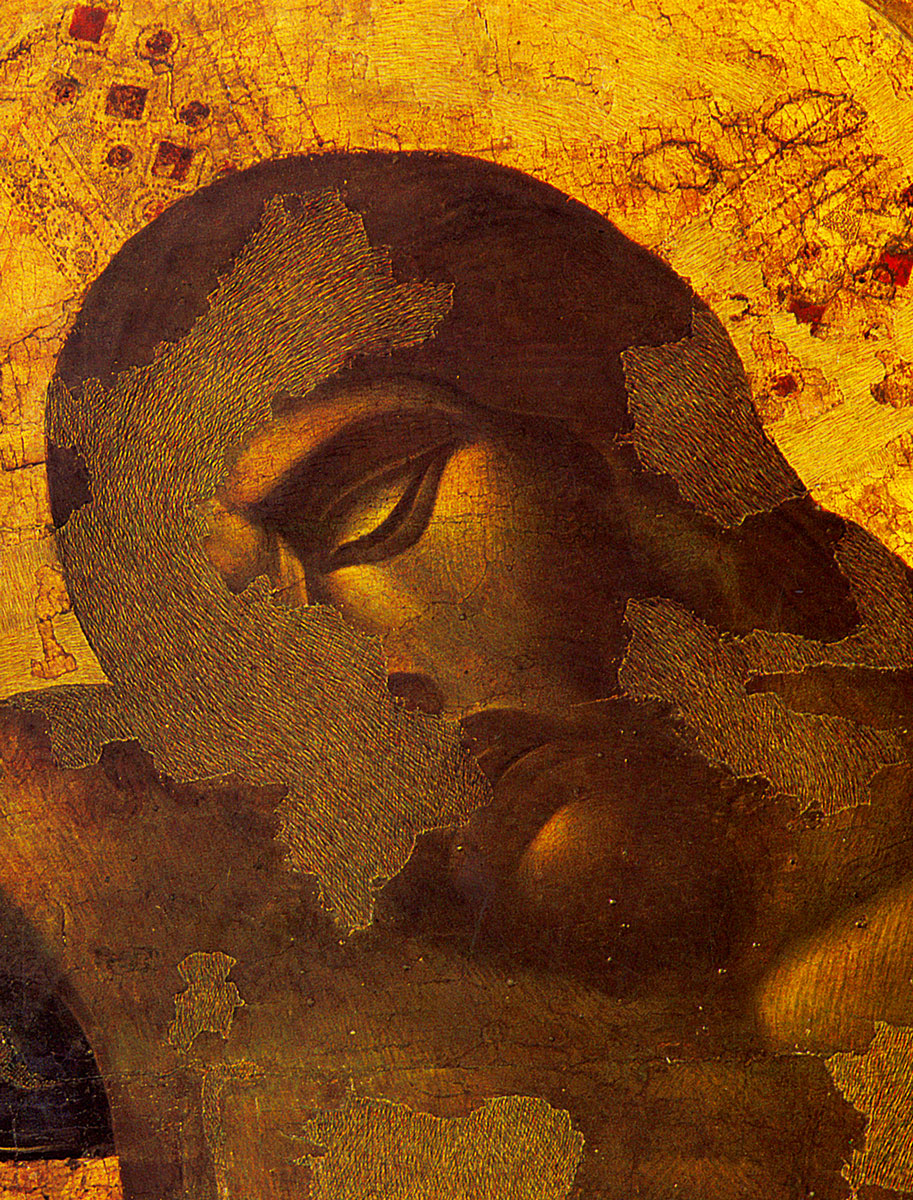
• • •
That was the idea, anyway. And it was an idea, and a practice, that held sway in Italy for much of the postwar period (Brandi lived until 1988, and remained a sovereign force in the peninsula’s artistic life to the end). Tratteggio even spawned schismatic sects and foreign emulators. In the 1960s, the Florentines, under the leadership of Umberto Baldini, cultivated a rival practice they called “chromatic abstraction,” which, thrown contemptuously into the teeth of Brandi’s (Roman) school at the time, nevertheless looks in retrospect like a very modest departure. It permitted the particulate hachures to cross; it admitted of some shifts in orientation of the resulting grid; it allowed a wee bit more coloristic latitude. Later, French and Belgian traditions arose that deployed the same general approach (what came to be known as “visible” in-painting, the general term for all the techniques that relied on ocular integration), but used pointillist dots or freer macchie, the technical term for a brushwork of specks and splotches.
On the whole, though, all of these approaches have now mostly passed from grace. There are still a few practitioners of the art of tratteggio, but only a small number of curators would currently consider submitting a work of significance to this treatment, and several famous examples of visible in-painting are these days widely regarded with horror (signally Cimabue’s Crocifisso, badly damaged in the Florence floods of 1966, and restored with extensive chromatic abstraction). Today, even in Italy, lacunae are, again, routinely handled by means of invisible in-painting, the kind of restoration that hides its tracks—exactly what Brandi loudly denounced.
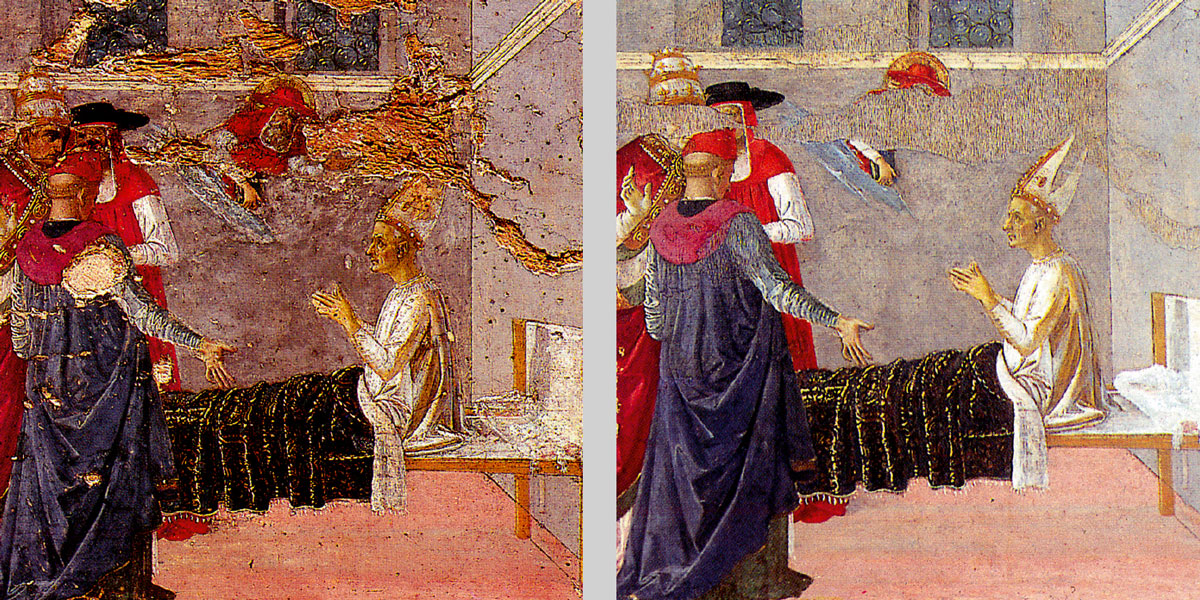
Interestingly, though, even the new “empirical” in-painters mostly consider themselves heirs to the great Cesare Brandi, and he is still invoked as the founder of the theory of art restoration. His legacy in the field is now understood to lie less in tratteggio per se (which, after all, he did not really invent—that honor properly belongs to his staff), and more in his concern with reversibility (tratteggio was uniquely undertaken in watercolor), and his ideas about the multiple temporalities of a work of art. Extending his central analysis of an artwork’s dual nature, he argued that the restorer had an obligation to honor both the historical moment of the work’s making and the historical time that it had gathered—that passage of time marked in the object itself and inextricable from its presence to consciousness. Brandi used the distinction to argue against excessively invasive efforts to restore works to their “original condition,” since their patina had become part of our experience of the works themselves. The philosopher of recovery had, it turned out, a very refined feel for decay.
In fact, as concerned as he was with restoration, Brandi’s life was, in effect, a long and complicated love affair with loss. As he got older, he would come to advocate that every restauro should preserve a small region of the original untouched, so that over time, through repeated restorations, a work would gradually become an intricate archive of its own ruin—an emerging fugue of temporalities, here hesitating, here in recapitulation, here performing counterpoint to its own eternal cadence. Voilà: the play of loss and recovery as the work of art itself.
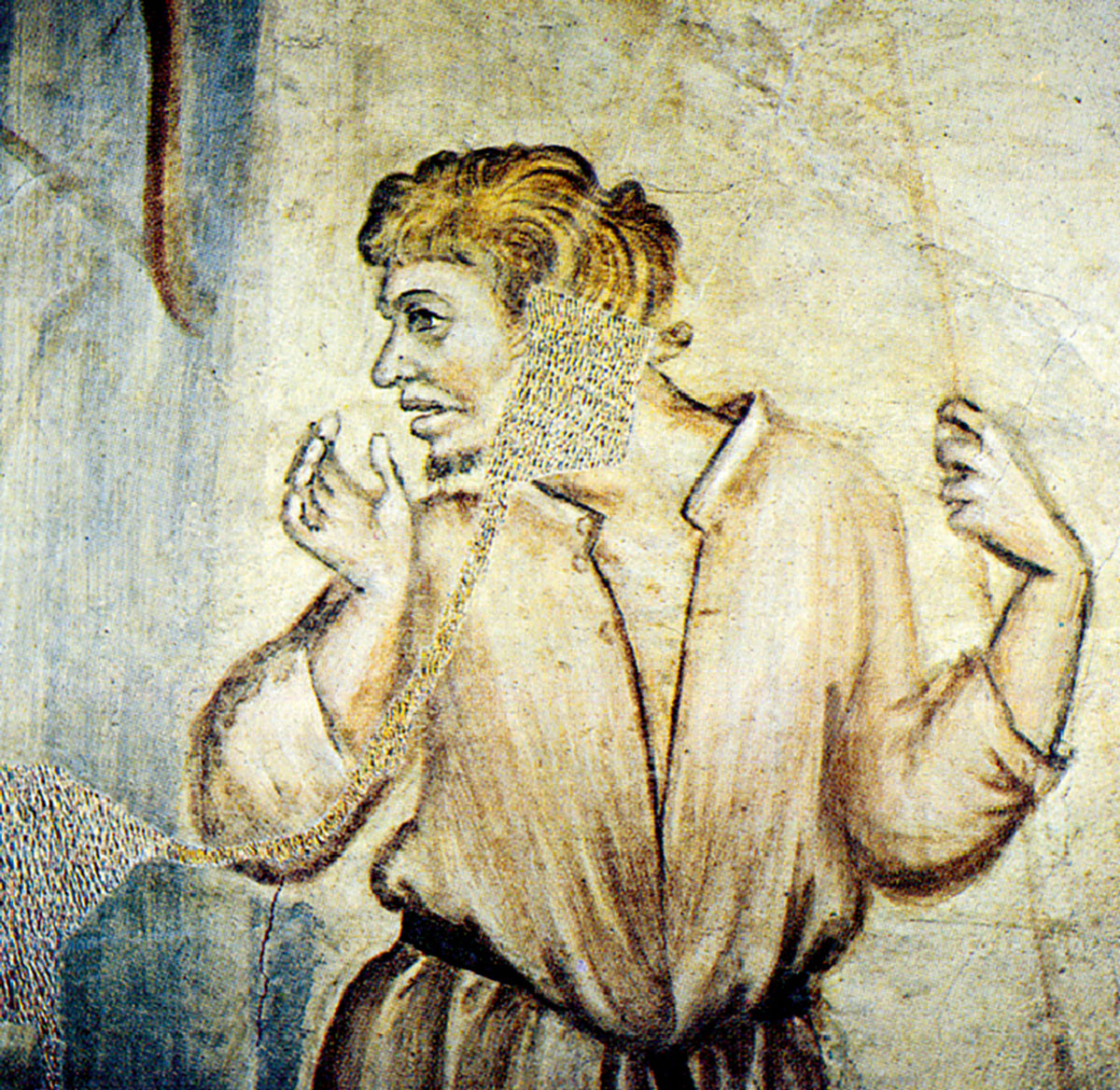
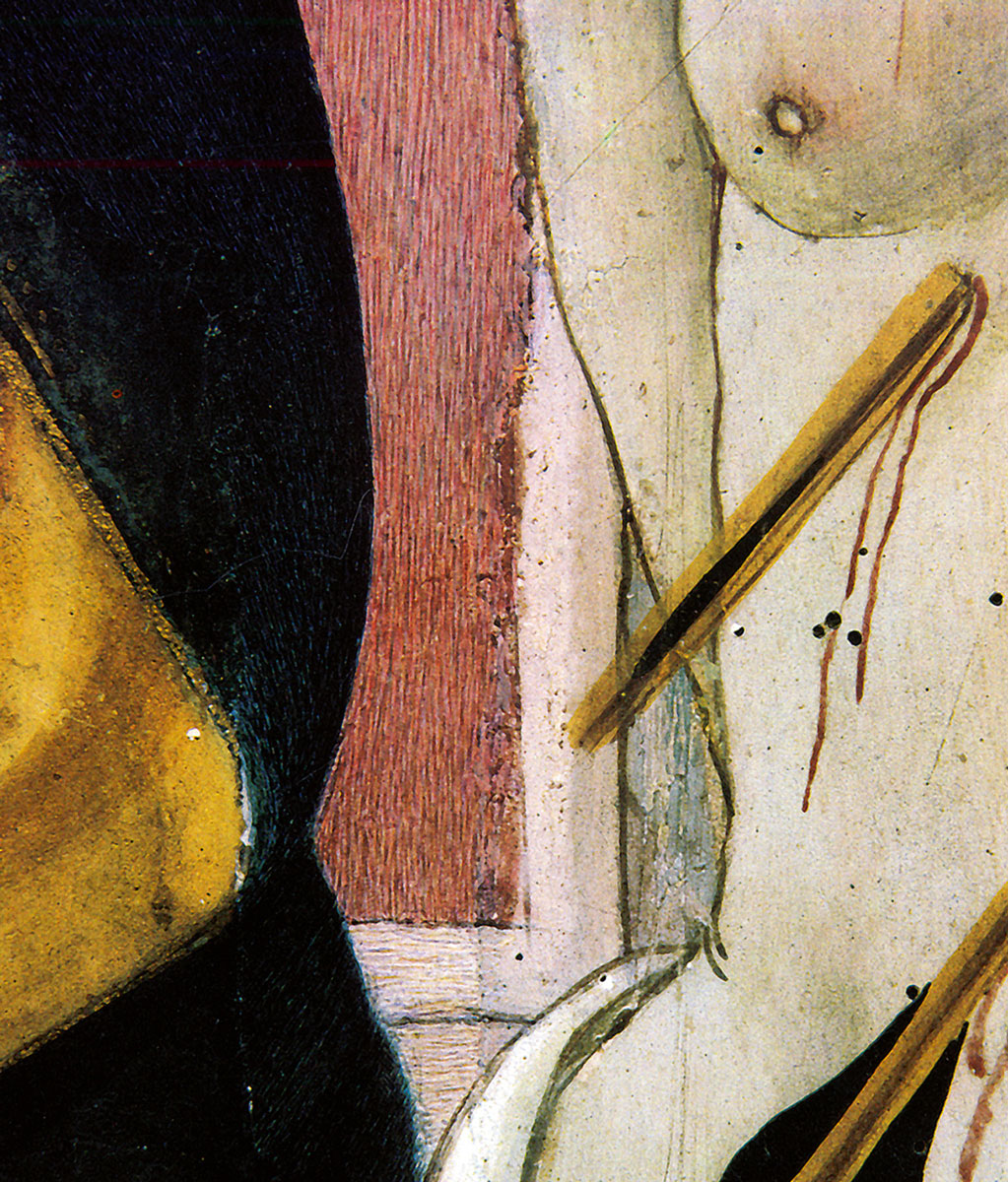
And this, finally, may be the right way to think of tratteggio. It looks like a tactic for recovery, but it may well be a strategy for loss. Or maybe it’s something in-between, a way of filling in that space between repair and resignation, method and metaphysics. How it works may depend, in the end, on where you stand: how near, how far. It is all this, I think, that gives me a shiver, looking at these works. In those small spaces one can—stepping close, stepping back—sense a roiling ambition to reconceive not just the past, but how we access it, and why: what we owe the dead, and ourselves, when we try to picture what is lost. Thought of this way, as a metaphor for historical practice per se, tratteggio creatively destabilizes conventional distinctions between historical fiction and the footnoted monograph, and inflects the act of recovering the past with spiritual (and aesthetic) significance. What would it be to write history using a version of this technique? To “fill in” what is missing by means of the textual equivalent of this peculiar convention? Suddenly it seems there is a great deal of work to be done.
So much for tratteggio as visual historiography. What about tratteggio as visual art? Here I would argue that these restorations merit reconsideration as significant twentieth-century artworks. Call the school “epistemic expressionism”—a visual idiom imbued with the torments of beauty in an age of truth. Indeed, one might go so far as to claim that visible in-painting has given us the only significant high allegorical paintings of modernism. How else to understand these hybrid creations if not as tiny, elaborate masques of the central problem of the modernist program: that uneasy, recursive dialectic between tradition and innovation, freedom and history. “Revolution,” of course, means a turn that brings you back to your original position. The avant-garde is forever at work forgetting this. And remembering.
• • •
What of what has been lost can be recovered? Looking at that little strip of the Maestà—up close, and then from a distance—one wants to say: “You can, you must, recover … the loss.”
D. Graham Burnett is an editor of Cabinet and teaches history of science at Princeton University.
Spotted an error? Email us at corrections at cabinetmagazine dot org.
If you’ve enjoyed the free articles that we offer on our site, please consider subscribing to our nonprofit magazine. You get twelve online issues and unlimited access to all our archives.